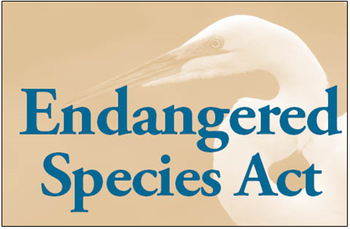Difference between revisions of "Endangered Species Act (ESA) (United States)"
(→Associated Laws and Regulations) |
|||
| Line 10: | Line 10: | ||
===Major sections=== | ===Major sections=== | ||
| + | The ESA has been amended over time, but several sections have continued to hold the most authority. Section 3 defines terms common in the document itself, some for the first time in the United States. Section 4 contains definitions of endangered and threatened species. It also states rules for species listing, critical habitat designation, and recovery plans. Section 6 of the ESA details State cooperation and collaboration; Section 7 lays out rules for federal agencies to avoid adversely affecting listed species and habitats; Section 9 bans the “take” or harm of a listed species. Section 11 lays out penalties and enforcement of the stipulations of the ESA, and includes information on citizen suits. <ref name="ESA">[http://www.fws.gov/endangered/esa-library/pdf/ESAall.pdf Endangered Species Act]</ref><ref name="CitGuide"/><ref name="Marrone">[https://www.novapublishers.com/catalog/product_info.php?products_id=40361 Endangered Species Act: Provisions, Policies, and Considerations]</ref> | ||
===Defining threatened and endangered species=== | ===Defining threatened and endangered species=== | ||
Revision as of 13:07, 10 April 2016
The Endangered Species Act (ESA) was established in 1973 with the objective to protect the flora and fauna of the United States from extinction. The ESA approach to animal, plant, and habitat conservation involves listing species as endangered or threatened, protecting their suitable habitats, and restoring healthy populations. The ultimate goal is species removal from the endangered list.[1] The ESA is primarily administered by the US Fish & Wildlife Service (USFWS) and the National Oceanic and Atmospheric Administration (NOAA).
Contents
History
Since colonization, the United States has experienced alarming and unprecedented rates of habitat destruction and species extinction. The first notable species to become scarce that was once abundant was the American bison in the 1800s; the disappearance of bison from grasslands caused concern nationwide.[2] Significantly lower numbers of other species, particularly the country’s symbolic Bald Eagle, spurred the extinction prevention movement.[1] In addition to setting guidelines for extinction prevention, the ESA also addressed previous governmental conservation efforts that were largely ineffective. The first attempt at wildlife conservation in the United States was the Lacey Act in 1900, which prohibited commercial trade of wildlife obtained illegally in or outside the United States.[3] The next two attempts at wildlife conservation legislation were precursors to the current ESA, the first being the Endangered Species Preservation Act of 1966, followed three years later by the Endangered Species Conservation Act. There was still a pressing need for more drastic, detailed measures to protect at-risk plant and animal species, thus the ESA was developed.
Legislation Overview
Major sections
The ESA has been amended over time, but several sections have continued to hold the most authority. Section 3 defines terms common in the document itself, some for the first time in the United States. Section 4 contains definitions of endangered and threatened species. It also states rules for species listing, critical habitat designation, and recovery plans. Section 6 of the ESA details State cooperation and collaboration; Section 7 lays out rules for federal agencies to avoid adversely affecting listed species and habitats; Section 9 bans the “take” or harm of a listed species. Section 11 lays out penalties and enforcement of the stipulations of the ESA, and includes information on citizen suits. [4][1][5]
Defining threatened and endangered species
The listing process
Critical habitat
Recovery plans and land acquisition
Consultation
Citizen suits
Collaboration with states
The ESA in California
Success stories
Notable court cases
Associated Laws and Regulations
Lacey Act 1900 Migratory Bird Treaty Act (MBTA) 1915 Bald Eagle Protection Act 1940 Endangered Species Preservation Act 1966 Endangered Species Conservation Act of 1969 California Endangered Species Act (CESA) 1970
Links
http://www.fws.gov/ENDANGERED/laws-policies/index.html
References
- ↑ 1.0 1.1 1.2 Citizen's Guide to the Endangered Species Act
- ↑ The Endangered Species Act: History, Conservation Biology, and Public Policy
- ↑ Lacey Act
- ↑ Endangered Species Act
- ↑ Endangered Species Act: Provisions, Policies, and Considerations
Disclaimer
This page may contain student work completed as part of assigned coursework. It may not be accurate. It does not necessary reflect the opinion or policy of CSUMB, its staff, or students.
